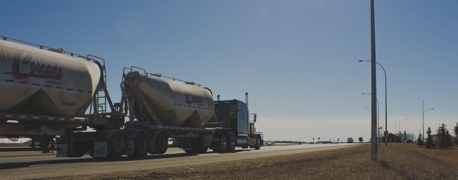6 Bad Driving Decisions That Are Good Driving Reminders

Have you ever watched a driver make a terrible decision and wondered how their vehicle was still in one piece? Have you ever had a close call that made you think twice about your own driving habits? Sometimes the worst driving decisions are the best reminders of how to stay safe on the road. As an employer who relies on commercial drivers, you need to instill good driving habits to protect your employees.
The Worst Driving Habits Remind Truck Drivers What Not To Do
Every 2 minutes, the average driver makes 400 observations, 40 decisions, and 1 mistake, according to a report by the Network of Employers for Traffic Safety (NETS). With the amount of time they spend on the road, commercial drivers should never assume that other motorists are paying attention or will make the right choices. Assuming the worst is a safer bet because they’ll be prepared for anything.
In addition to observing traffic laws and trucking regulations, employers should encourage their drivers to drive defensively and learn from other motorists’ mistakes.
1. Driving While Distracted
Distracted driving is one of the worst driving habits, and one of the most common. In fact, according to National Highway Traffic Safety Administration (NHTSA) statistics on distracted driving, 3,142 lives were lost in the U.S. in 2019 as a result of traffic accidents involving distracted drivers. This accounted for 9% of fatal accidents that year. Texting and other handheld cellphone use are the biggest distractions for motorists, particularly teens and young adults.
A person who is texting while driving is distracted in three distinct ways:
- Their attention is not on driving
- They are not looking at the road
- One or both of their hands are not on the wheel
As seen in the following video, distracted drivers can easily cause serious crashes. Drivers should never presume that another motorist is paying attention or will obey traffic laws. Employers should have a zero-tolerance policy on texting and other distractions while driving. Commercial drivers can protect themselves by remembering that most drivers are guilty of this bad habit.
2. Unsafe Lane Changes
Lane changes can be tricky in moving traffic, especially for tractor-trailers and other large vehicles. Blind spots and the sheer amount of space a commercial vehicle requires on the road can make lane changes a source of trouble.
The following are examples of bad driving decisions by motorists when changing lanes:
- Making sudden lane changes
- Not using a turn signal to indicate an intended lane change
- Changing lanes without checking mirrors and blind spots
- Moving across multiple lanes at once
In the following clip, we see the view from a truck driver’s dash cam as a car changes lanes directly in front of his vehicle. The driver of the car and the truck were both lucky that there was no collision. Had the truck driver been distracted or speeding, this could have ended tragically.
Truck drivers can avoid crashes caused by unsafe lane changes by allowing enough distance between their vehicles and others on the road and by being aware of every vehicle they share the road with, even those in adjoining lanes.
3. Following too Closely
One of the biggest mistakes drivers make is following too closely behind another vehicle. Following too closely behind a truck is particularly dangerous, as motorists in smaller vehicles cannot see around or in front of the truck. If there is a change in traffic or an object in the road and the truck driver must slow or stop, a rear-end accident is likely. There is also a significant risk of an underride accident, where the smaller vehicle runs under the rear of the truck.
Truck drivers can reduce their risk of a rear-end accident by maintaining a safe following distance and allowing for extra room during bad weather or if they are carrying a heavy load, as that will affect how long it takes to stop their vehicles.
4. Speeding
Every year, about one-third of traffic accident fatalities occur in speeding-related crashes. Driving above the posted speed limit or too fast for current road, traffic, or weather conditions can have deadly consequences, as the severity of a crash will be magnified at higher speeds. Speeding also gives a driver less time to slow or stop for another vehicle or an obstacle in the road. Speeding drivers are also more likely to make unsafe lane changes as they weave in and out of slower traffic. All of these factors make speeding one of the worst driving decisions—and a reminder of good driving practices.
In addition to observing speed limits, truck drivers can protect themselves and everyone on the road by being vigilant in watching other drivers’ behavior, allowing extra room around their vehicles, and reporting speeding when they see it.
5. Drunk Driving
Drunk driving is illegal, but it is still a leading cause of traffic accidents across the U.S. The NHTSA reports that over 30% of fatal collisions involve drivers with blood alcohol levels above the legal limit. With the amount of time they spend on the road, particularly late at night, truck drivers are more likely to encounter drunk motorists.
Employers should enforce drug and alcohol testing according to state and federal regulations. Truck drivers should take extra care on the road and should call 911 to report any driver who appears to be intoxicated.
Potential signs of drunk driving include:
- Driving too slowly
- Swerving in and out of a lane
- Delayed reaction time
- Quick acceleration or deceleration
- Almost hitting an object, curb, or vehicle
- Erratic braking
- Driving off the road
6. Driving in Bad Weather
Rain, snow, fog, and wind can limit visibility and make roads dangerous, putting everyone on the road at risk. Unfortunately, some drivers decide to get behind the wheel anyway and drive as they would on a clear, sunny day. They don’t take into account the fact that there may be black ice, invisible to the eye, and potentially deadly if proper care isn’t taken.
Drivers need to adjust their speed, make slower turns and other maneuvers, and be extremely cautious when driving in heavy weather. If the weather is too bad, they should pull over and wait it out, if possible. If they haven’t taken to the road yet, they should stay home or in another safe place while it passes.
Speeding and careless driving in bad weather serve as reminders of how important it is to check the forecast and plan accordingly, as shown in this compilation of weather-related accidents.
Representing Injured Truck Drivers Nationwide
Arnold & Itkin represents truck drivers across the country who have been injured on the road or while performing any of their job duties, including inspecting, maintaining, loading, or unloading their trucks. Our truck accident lawyers have seen firsthand just how disastrous bad driving habits can be, and we are committed to sharing tips and information that can help keep everyone on the road safe.
To find out more about our firm, our attorneys, and our commitment to helping the injured, call (888) 493-1629 or contact us online.
- Categories


